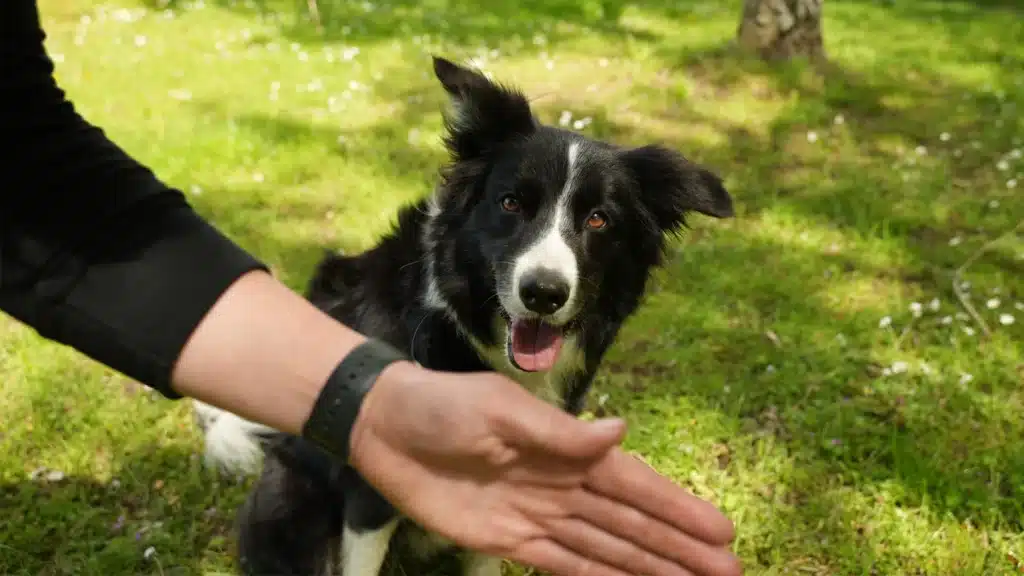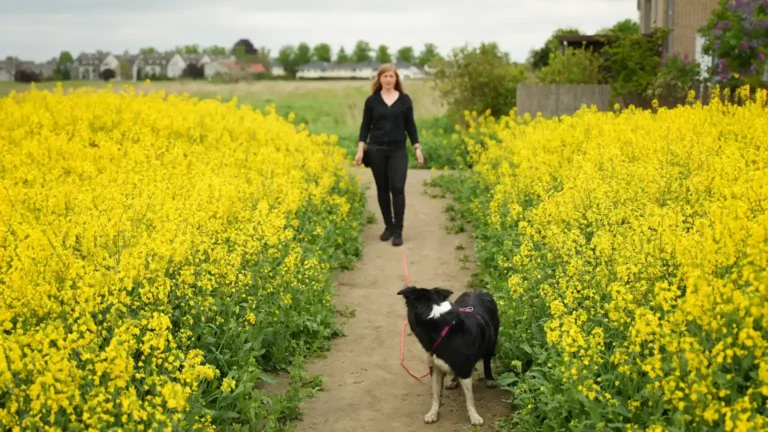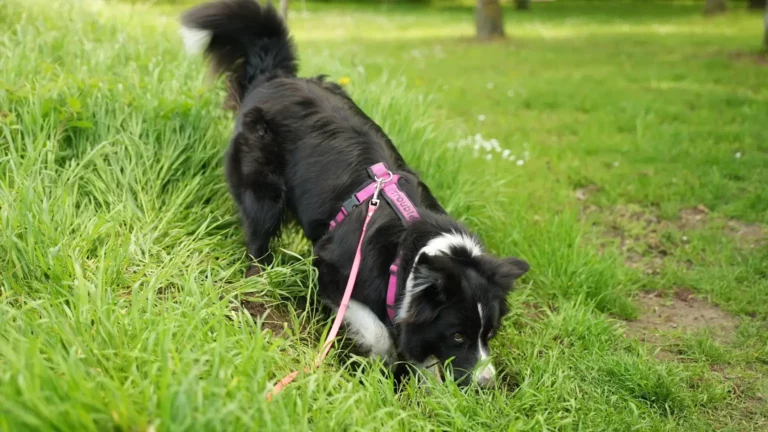Why Your Dog Doesn't Listen To YOU - 5-Step Guide
- Anja Boecker
- Updated: 2023-08-28
The dog-human relationship has a lot to do with trust and loyalty. But sometimes there are situations where you desperately wonder why he just won't listen. This guide will help you!

Disobedience is a big problem for many dog owners. It can quickly become stressful for you and your furry friend.
But I will help you with this article. I will go into the problems of disobedience and show different solutions. There is also an easy 5-step guide to follow right away 🙂.
Situations to Watch For

1. You’ve Used the Same Command Multiple Times.
You have probably used the same command more than once. This behavior does not help. In fact, it reinforces your dog's disobedience.
If you repeat a command or instruction, your pet will know that you will do it over and over again.
That is, he deliberately does not listen to the command, because he assumes that it will be repeated - a vicious circle.
The result is awkward moments of desperately repeating yourself to get your furry friend to obey.
2. Dominance Plays a Big Role
Dogs should and want to be "dominated". To dominate means Your dog knows that you are the leader in your relationship.
This may sound a bit bold, because dominance is often misunderstood. Dominance does not mean the arbitrary or even aggressive exercise of power over others. Dominance should always be accompanied by a great deal of love and empathy.
Rather, it is a consistent and loving relationship. It sets clear boundaries for the benefit of all involved.
3. Unclear Commands
Four-legged friends follow orders. But only if the commands are clear and precise. Your furry friend not only hears the command itself, but also looks at your posture, gestures, and facial expressions.
You can explain the orders and commands to your pet as friendly as you like. It does not help if you already have a negative attitude.
If you call "heel" in a friendly manner while pulling aggressively on the leash, you will confuse your dog. The type of command you use must match your posture, facial expressions, and gestures.
4. Commands at the Wrong Time
Of course, you have to wait for the right moment to give the command. The best negative example is the following:
You give the command while your dog is doing business. A sure instinct is required here.
5. False Links Regarding the Reward.
You should always reward your protégé when he does something right. However, the reward should not be too long in coming. This is because your dog will associate the reward with the situation in which he receives it.
Does it take a little longer to pull the reward out of the bag? Then maybe the ideal moment has already passed.
Reasons for Disobedience
Before we get to the main part of the article, let's take a look at disobedience. Because there are exceptions. Exceptions that show that your dog is not disobedient at all.
Teething and puberty are such exceptions. These are stages that usually go away on their own.
Teething

When your dog gets new teeth, it's a difficult time. Many dog owners confuse this stage with disobedience. That's why you need to watch your dog closely.
If his teeth are due for replacement and he is acting "rebelliously," it has nothing to do with disobedience.
Many furry friends are restless and/or nibble on objects around the house during teething. The natural reaction is to admonish the dog. However, this usually doesn't help much.
By chewing, your dog is trying to relieve pressure on his teeth. Look for a chew toy at the pet store.
Puberty
You don't understand the world anymore because your dog suddenly doesn't listen to you. Have you ever thought that he is going through puberty?
You may also confuse your dog's disobedience with puberty. Puberty is also just a stage. Disobedience and rebelliousness during this time should not be judged too harshly.
Here's what you need to know. Don't give your dog too many commands during this time. Your dog will not be able to follow all of your commands.
That's why it's important to keep reminding yourself that this is just a phase. A phase that will soon be over.
So limit the number of different commands and commands. Use only the commands that are really important at that moment.
5 Practical Tips for Different Situations
In this section, we will look at some specific situations in more detail.
Situation #1: Your Dog Doesn’t Listen to You
In this case, we are assuming it is an adult dog. A clear example would be an adult dog from the shelter that has been abandoned.
Notice: Raising an adult dog can be more difficult than raising a puppy that grew up with you.
Most of the time, you don't know the exact history of the animals from the shelter. This can lead to communication problems in the beginning. The dog needs time to adjust.
It must be emphasized that patience is the best solution. If it still does not work, we recommend consulting an experienced dog trainer.
Tip 1: Unique Command
It is important that you think carefully about the command you choose. The command you choose should be distinctive. So choose a term that is different from other commands.
Tip 2: Practice on a Leash First
To reduce disobedience, do the exercises with your dog on a leash. You have more control over your dog on the leash. It is not advisable to do the exercises while the dog is off-leash.
Tip 3: The Quiet Environment Matters
It is also important to do the exercises with your dog in a quiet place. Noise, banging around, children playing, different smells and other dogs are counterproductive to success.
Tip 4: Praise, Praise, and More Praise
Of course, this may sound excessive at first. But you should always praise your pet as soon as it does something right. You can never give too much praise. So praise, praise, praise. But only when your dog has really done something right.
Tip 5: Constant Repetitions
The best exercises are useless if your pet doesn't do them over and over again. Therefore, it is important that you repeat the exercises on a regular basis. Make sure your pet is not inundated with stimuli. Only when your dog has mastered one command can you teach him the other.
Situation #2: My Dog Used to Listen but Has Stopped
Does your dog stop listening to you? - There are several reasons for this. The most common reasons for sudden disobedience can be:
- Delayed puberty
- Your dog does not hear or see well (due to age)
- His behavior has changed recently
- Physical ailments
In the case of late adolescent behavior, you can do what we recommended above. Because this behavior is also just a stage.
Review this behavior with your veterinarian or dog trainer. They may be able to tell you if your dog is in this stage.
It is also possible that your furry friend is older and has problems with vision or hearing.
When a dog becomes a senior varies from breed to breed. But the fact is that as they age, furry friends often suffer from vision and hearing problems.
A visit to the veterinarian can clarify this. If your dog no longer listens to you because of his age, our advice is to continue to be patient and loving.
You may also be the reason your dog doesn't listen to you. Could it be that you have been under more stress than usual lately? Or have you been traveling a lot?
These are all possible reasons. If your behavior has changed, it may be confusing your dog. Think carefully if this could be the reason for your dog's behavior.
Does he have any physical ailments? It also happens that a dog becomes disobedient when it is in pain or sick.
Then it is important to observe your dog's behavior closely. Here are some questions to ask yourself:
- Is your dog eating and drinking enough?
- Does he have a toothache?
- Is he apathetic?
- Does he limp?
- Does stool and urine pass easily?
- Has your sleep pattern changed?
If you suspect health problems, you should consult a veterinarian directly. He or she will be able to diagnose the problem and make recommendations for improvement.
Situation #3: My Puppy Won’t Listen to Me

Your puppy won't listen to you? This happens more often than you might think. Puppyhood is full of surprises and discoveries for your dog. Patience is the key.
Patience is an important factor in dog training. However, with an adult four-legged friend, you may need to be stricter at times.
However, this is not recommended for puppies. To help you get through this period without stress, we have some helpful tips for you:
Tip 1: Provide Variety
A puppy can get bored easily. Variety is important. Especially on walks, you should keep things interesting.
Tip 2: Positive Links Also Apply Here
Your puppy should also associate commands with something positive. Positive associations teach your puppy that he is worth listening to. You can practice this at home. Small successes are usually quicker in familiar surroundings.
Tip 3: Create Clear Terms
Puppy age is usually defined as the first 20 weeks. During this time, clear relationships should be established. Relationships like, "Who is the alpha dog here?" This is important to your little friend. Especially in the first few weeks, your furry friend may try to test his limits. Show him his limits lovingly and consistently. This will help him learn who's in charge.
Tip 4: Reward and Praise
When training your puppy, reward and praise should always come first - provided your dog does something right. Also, be sure to give the reward immediately when your dog does something right. If you wait too long, he may associate the reward incorrectly.
The same goes for behaviors you want him to avoid. Your protégé won't remember what he did wrong. If you want to tell him not to pee on the carpet 10 minutes after he's done his business, he won't do it.
Situation # 4: Dog Doesn't Listen and Runs Away
Before we provide important tips at this point, let's first take a look at possible reasons for this behavior:
- The environment is unfamiliar
- Your dog is in heat
- He is afraid
- Noisy, unstable environment
- Your dog follows its hunting instinct
There are different methods depending on the situation. Methods to help you eliminate your dog's disobedience.
In an unfamiliar environment, it is important to slowly acclimate your dog. The leash is the key.
The same is true if your dog or bitch is in heat. If your dog or bitch is in heat, it is imperative that you keep her on a leash.
If your dog is afraid, it often helps to calm him down. In general, you should choose environments that will not frighten your dog.
The following tips may help:
- Practice the recall command again
- Repeat exercise regularly
- If not already done, include rewards and praise
- Focus their attention on you
- Employment during the walk is beneficial
Situation # 5: Your Dog Doesn’t Come When You Call

This is the easiest situation to improve. Because there is such a thing as a universal solution: the long leash.
You can use the long leash to train and recall your dog. For more information, see our article on long leashes. Long Leash Training.
When your dog doesn't heed your recall, it's not only frustrating, it can be dangerous. Reliable recall is one of the most important commands a dog should learn. Here are some tips on how to improve recall:
Safety First! Until the recall works reliably, you should only let your dog run free on a leash or in a safe area.
Your dog will be more likely to respond to the recall if he associates it with a positive experience. Reward him generously each time he comes.
When training, start in an environment with few distractions so your dog can focus on you. Use a clear, consistent recall command such as "Come" or "Here".
Start by calling your dog to you from a short distance. If this works well, slowly increase the distance and add distractions.
Use special treats or his favorite toy as a reward. The reward must be immediate so the dog can make the connection to the command.
Clicker Training: A clicker can enhance communication. A click signals to the dog that he has done something right and now a reward follows.
Double Call: Some people use an "emergency" command, which is only used in critical situations and always comes with a very high reward.
Chase Game: Some dogs find it exciting to run away when called. This can turn coming back into a game and increase the likelihood that your dog will quickly return to you.
Remember to Follow These Tips! No punishment! When your dog finally comes to you, you must not punish him, even if he did not hear before. Otherwise he will associate coming with negative consequences.
The more you practice, the better your memory will be.
→ If you are having difficulty training yourself to remember, professional help may be helpful.
With regular training and a lot of patience, you can teach your dog a reliable recall. This is an investment that will pay off in the long run, both for your dog's safety and for your peace of mind.
Situation #6 Dog Ignores Me and Does What He Wants

If your dog is doing what he wants and ignoring your commands, it's important to find the cause and take action. Here are some suggestions:
- Health Check: Visit the vet to rule out any health problems that may be affecting his behavior.
- Daily Routines and Needs: Make sure your dog gets enough exercise, play and mental stimulation. An under-stimulated dog can be more difficult to train.
- Simple Commands and Positive Reinforcement: Start with simple commands and reward him immediately when he does them. Use treats, toys or petting as rewards.
- Be Consistent: Always use the same commands and rewards so your dog understands what you want him to do.
- Train in a Low-Distraction Environment: Start training in a quiet environment and then slowly increase the level of difficulty.
- Set Clear Boundaries and Rules: Your dog needs to know what he can and cannot do. Be consistent, but fair.
- Clicker Training: A clicker can help improve communication with your dog. Each time he performs a desired behavior, he receives a click and a reward.
- Ignore Unwanted Behavior: If your dog exhibits unwanted behavior, ignore it until he calms down. Then reward positive behavior.
- Set Rules for Everyone: Everyone in the household should follow the same rules for the dog to avoid confusion.
- Seek professional help: If all else fails, consider professional help. A professional dog trainer can recommend specific techniques and exercises that are appropriate for your dog.
Patience is important. Change doesn't happen overnight. Be patient and consistent, and try to view training as an opportunity to spend quality time with your dog.
Remember that training is not only about teaching your dog what to do, but also about strengthening the bond between you.
Frequently Asked Questions
There are many reasons why your dog may not listen to you. Puppies and adolescent dogs are often in a phase where they have a hard time concentrating. Your dog may also be older and not listening.
First, find out why your dog doesn't listen to you. Then you can do something about it. In general, a good relationship between you will always help.
Dogs learn commands most quickly when you immediately associate correct performance with something positive, such as a treat. This will condition your dog to do the command.
It's best to choose a quiet place to train, and the time of day doesn't matter. Just be careful not to overexert your dog. Train in short intervals, but more often.
You can walk your dog several times a day. Three times a day is a good average. Depending on how attentive your dog is, you can train more or less often. Try not to exercise for more than 15 minutes at a time.
Conclusion
In the wonderful but sometimes hairy journey of dog training, communication between you and your four-legged friend can sometimes feel more like a missed connection than a harmonious symphony.
When that naughty rascal follows the squirrel instead of your call, the feeling of powerlessness can be overwhelming. But with our 5-step guide from leash to irresistible treat, you can start a whole new chapter in your relationship.
The magic is not only in the techniques, but also in the relationship you develop with your dog through these training sessions. Your bond becomes stronger and trust grows. At the end of the day, it's not just about your dog listening, it's about your dog listening to you because he wants to, not because he has to.
So grab some treats, your clicker, and most importantly, some patience, and set the stage for a successful communication show where you and your dog are the stars.
Remember:
The journey from disobedient speedster to loyal companion is not a sprint, but a marathon you will run together.

My name is Anja Boecker, and I am a certified dog trainer and behavior consultant. With these articles, I want to help you to understand your dog better and to build an inseparable bond.
Share Now:


Hello, our dog's name is Henry and he is a 2,5years old roughhaired dachshund. He is a very nice dog. He can sit, stop, left, right, only place we do not get but have a very big problem when we go out. If people come towards us and we talk, he starts barking at the top of his lungs and only stops when we move on. I am avoided by almost all people, with or without dogs, and I am insulted. Acquainted people go already on the other side, some have already told me I should educate my dog.there are insulting sayings and insults of their side pronounced. My dog times are fixed meanwhile I have the whole walk for us, the people no longer go for a walk at the same time as we do. I am all alone with our dog. My husband can also not go for a walk with, then he also klefft in a tour. We have had many dogs, but we have never experienced anything like this.I come home with the dog a few times and start crying because people have insulted me again. Henry is such a sweet dog. At home he is quiet and does not bark at all. The mailman can come or it can be noisy, visitors can come, that's all o.k. he doesn't bark then .Only the problem outside with other people, we don't get it. What can we do? Please give us a tip to remedy the situation, we would be very happy about it. One more note: We got Henry during the time of Corona, dog training was not possible.
Hello Marion, we can understand very well how much the problem burdens all concerned. It is therefore all the more important that you do something to change Henry's behavior. The following would be important:
Use a positive approach: Reward Henry when he stays calm. Punishing would be rather counterproductive.
Familiarize yourself with the concept of "ignoring": ignore Henry's barking instead of responding to it. By not paying attention to Henry's barking, you are signaling to him that this behavior will not be rewarded. You are depriving him of attention, so to speak.
Train the "place" command: This can help keep Henry calmer when he encounters other people and dogs. Practice this command at home first, in a quiet environment, until it sits properly. Then outside in a quiet place without passersby or dogs, and finally gradually on trails with light distractions, etc.
You can make up for the missed training with a dog coach due to Corona restrictions. It is never too late for that. A professional trainer on site can also give you more tips on how to correct Henry's behavior, as he can better assess what the problem is and where to improve the behavior pattern.
Until then, it is advisable that you continue to choose your routes where no passers-by will pass by.
It is important that you have patience and practice with Henry regularly.... It may take some time for Henry's behavior pattern to change. But with consistent training and positive reinforcement, it is definitely possible.